Quick search
CTRL+K
Quick search
CTRL+K

Perth is the largest city in Western Australia and also the capital of the state of Western Australia. The city is named after Perth in Scotland, and with more than two million inhabitants in the metropolitan area, it has grown rapidly from its founding in 1829 to the present.
Perth offers a wide variety of sights and activities. The city’s skyscrapers in the central business district tower up and create a beautiful skyline that can be seen from many of the city’s recreational areas. In Perth, there are large parks and water that serve as oases for both citizens and tourists.
There are several museums in Perth. You can get acquainted with the history of Western Australia, thereby gaining an exciting insight into the construction of a remote colony that was first linked with the rest of Australia by the opening of the famous Indian Pacific Railroad. The course still runs today across the Australian countryside from Perth towards to east coast.
Around Perth there are many activities waiting to be enjoyed. The port town of Fremantle is a suburb, and sailing to and from here is a popular choice. The Indian Ocean beaches also beckons in Perth’s climate, which is nice during hot summers and mild winters.

Western Australian Museum is a kind of national museum for the state of Western Australia, and here the history, culture and nature of the great state are depicted. The large exhibition is particularly interesting and gives a good overall impression of both Perth and the region around the city.
Founded in 1891 as the Geological Museum, the museum opened in the Old Perth Gaol, which dates from 1855. The geological collections were soon expanded to include ethnography, biology and other areas of interest to the museum, the government and visitors.
Today, the Western Australian Museum has several departments, of which the largest and best-known department is located on James Street in Perth. After major redevelopment, this department reopened in 2020 in a complex of several buildings, of which Old Perth remains one.
The museum branch in Perth is also known as WA Museum Boola Bardip, and here you can enjoy various permanent exhibitions such as WA Land and People, which is a historical depiction of Western Australia, Diamonds to Dinosaurs with various interesting finds and Katta Djinoong, which conveys the state’s Aboriginal history and culture.
Government House is a stately mansion built 1859-1864 as a government building and residence for the Governor of the State of Western Australia. It still has that role and is thus the seat of the representative of the country’s monarch.
The site was already used by the first governor after the establishment of the Swan River Colony in 1829, and today’s Government House is the third governor’s residence to have been located here. It was Edmund Henderson who designed the mansion primarily in the so-called Jacobean style.
The unique architectural character of the building is characterized by the use of brickwork with mullioned windows, decorated gables and slender towers. This gave Government House an almost castle-like appearance. The mansion is also beautifully furnished with many fine rooms and halls such as the Ballroom and the governor’s office.
St Georges Terrace is the main street in Perth, and here you can experience both metropolitan experiences and the city’s history. The street goes back to colonial Perth, and its name comes from the 19th-century St Georges Cathedral, which can still be seen along St Georges Terrace.
The central part of the street between Barrack Street and William Street was built up homogeneously in the 1930s and 1940s with relatively uniform architecture and building height. This was largely how St Georges Terrace stood until the 1970s, when older and lower buildings were replaced by modern high-rises.
However, Perth’s previous tallest buildings were also located on St Georges Terrace before the 1970s. This applied, for example, to the Colonial Mutual Life Building, which was the city’s tallest from 1936 to 1962 with eleven floors. Since then, many higher buildings have been built, such as Central Park at the address 152-158 St Georges Terrace, which opened in 1992 with a height of 249 metres.
Along the street you can see several buildings worth seeing. One can start in the southeast at Victoria Avenue and go northwest. Here, the modern Perth Concert Hall, Government House and the Supreme Court of Western Australia are located on the south side, while St George’s Cathedral and the Old Treasury Buildings are located to the north.
The low buildings are replaced by high-rise buildings between Barrack Street and William Street, where you can also see the charming shopping arcade London Court, which was built in 1937 in fine Tudor style, Trinity Church from 1893 and the fine shopping street Trinity Arcade. On the corner towards William Street is the former Palace Hotel from the gold digging era in 1897.
On the following part of the street, there are also low buildings in the shadow of the skyscrapers. Here you can see, among other things, the redstone building that was built as the Perth Technical School in 1910. Next to it you can see the Old Perth Boys School from 1852, which stands as the oldest public school building in Western Australia.
On the westernmost part of St Georges Terrace, you pass The Cloisters building, which was built as a school building in 1858 by convicts in the colony at the time. A little further west is St George’s House, which dates from 1891-1892.
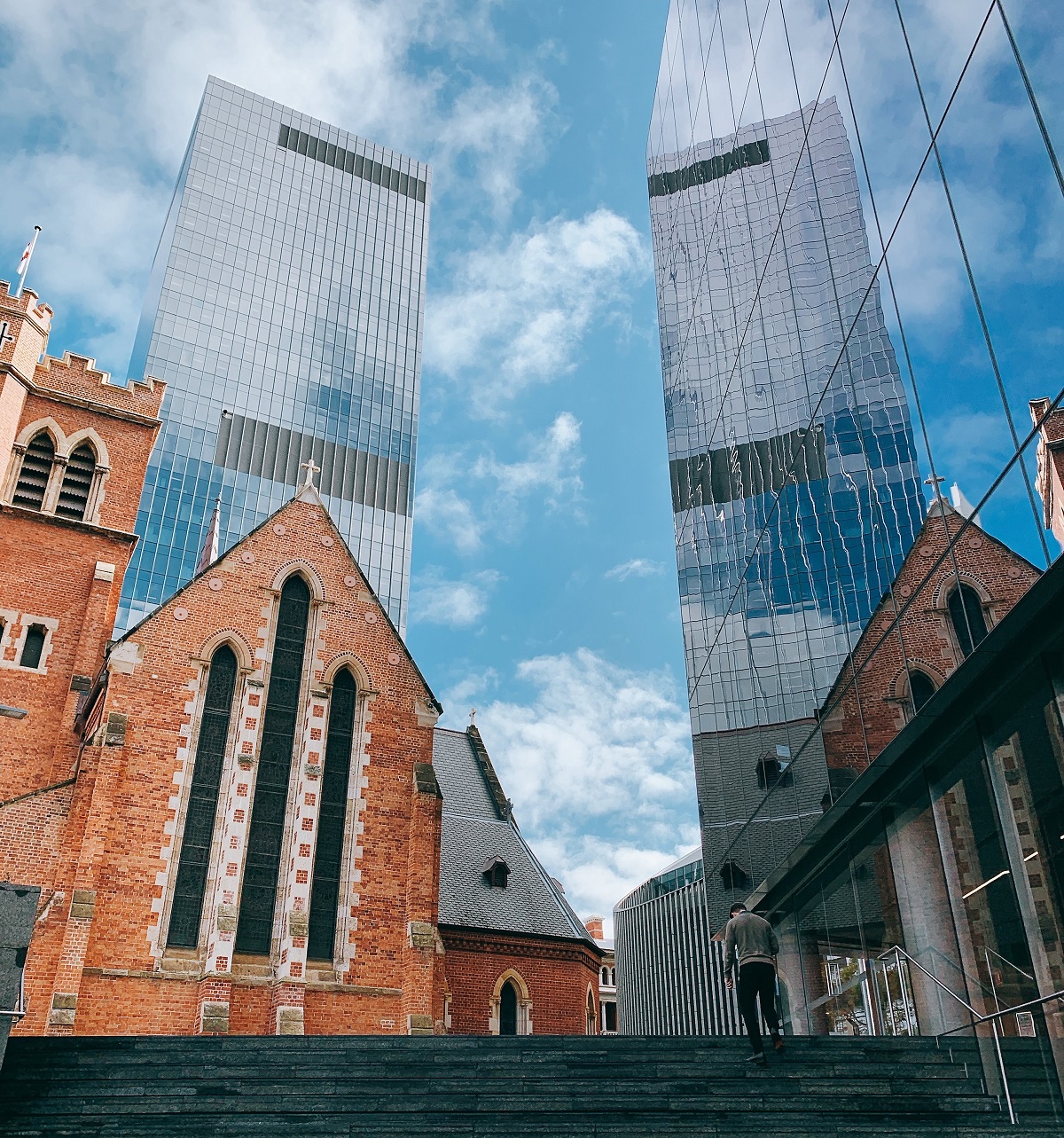
St George’s Cathedral is Perth’s beautiful Anglican cathedral. It was built in neo-Gothic style in the years 1879-1888. As a cathedral, St George’s Cathedral is the city’s most important Anglican church, and today the once large building is surrounded by the city’s high-rise buildings, which stand in stark contrast to the 19th-century building.
The cathedral was built as a beautiful red stone building, and in the church room a beautiful experience awaits visitors. You can see fine arches, ceilings and stained glass windows in the airy church. The architecture is neo-Gothic in the Victorian Academic style, and it was Edmund Blacket who was the primary architect for the building.
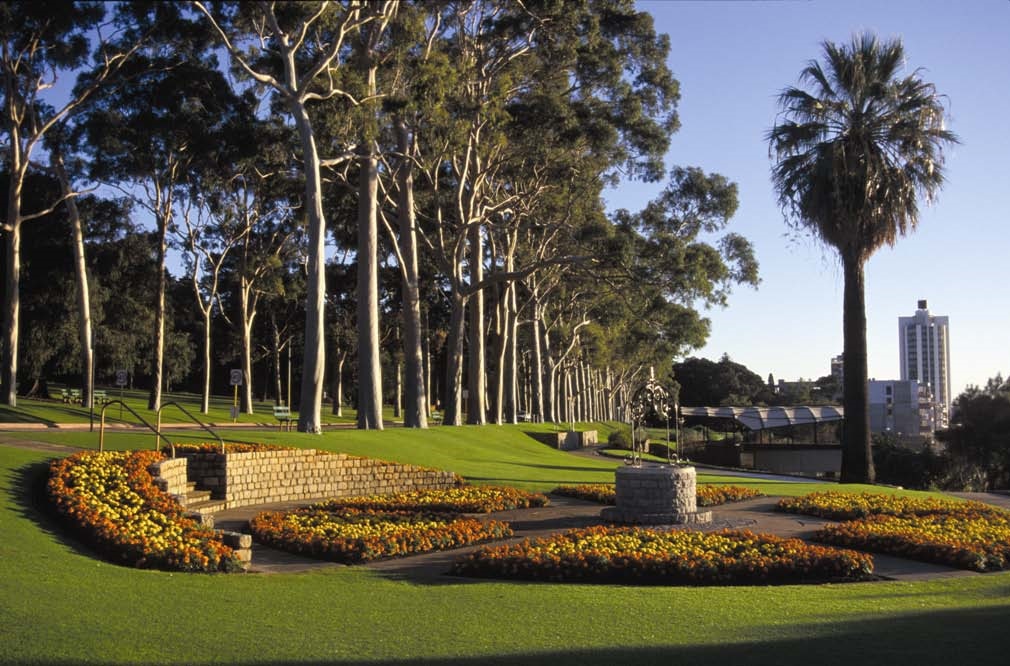
King’s Park is a large park that ranks as one of Perth’s most visited recreational areas. Here landscaped park areas from the foundation in 1872 lie side by side with the natural Australian bush landscape. In total, the park spreads over 400 hectares.
There are wonderful walks to be had in King’s Park, and in many places you can enjoy excellent views of Perth’s city center and the Swan River. In the park you can also see the State War Memorial and a nearby eternal flame.
The State War Memorial consists of, among other things, a cenotaph, which is an 18 meter high granite obelisk that honors all from Western Australia who gave their lives in the service of their country. The foundation encloses an inner crypt, the walls of which display the names of more than 7,000 members who fell in service.
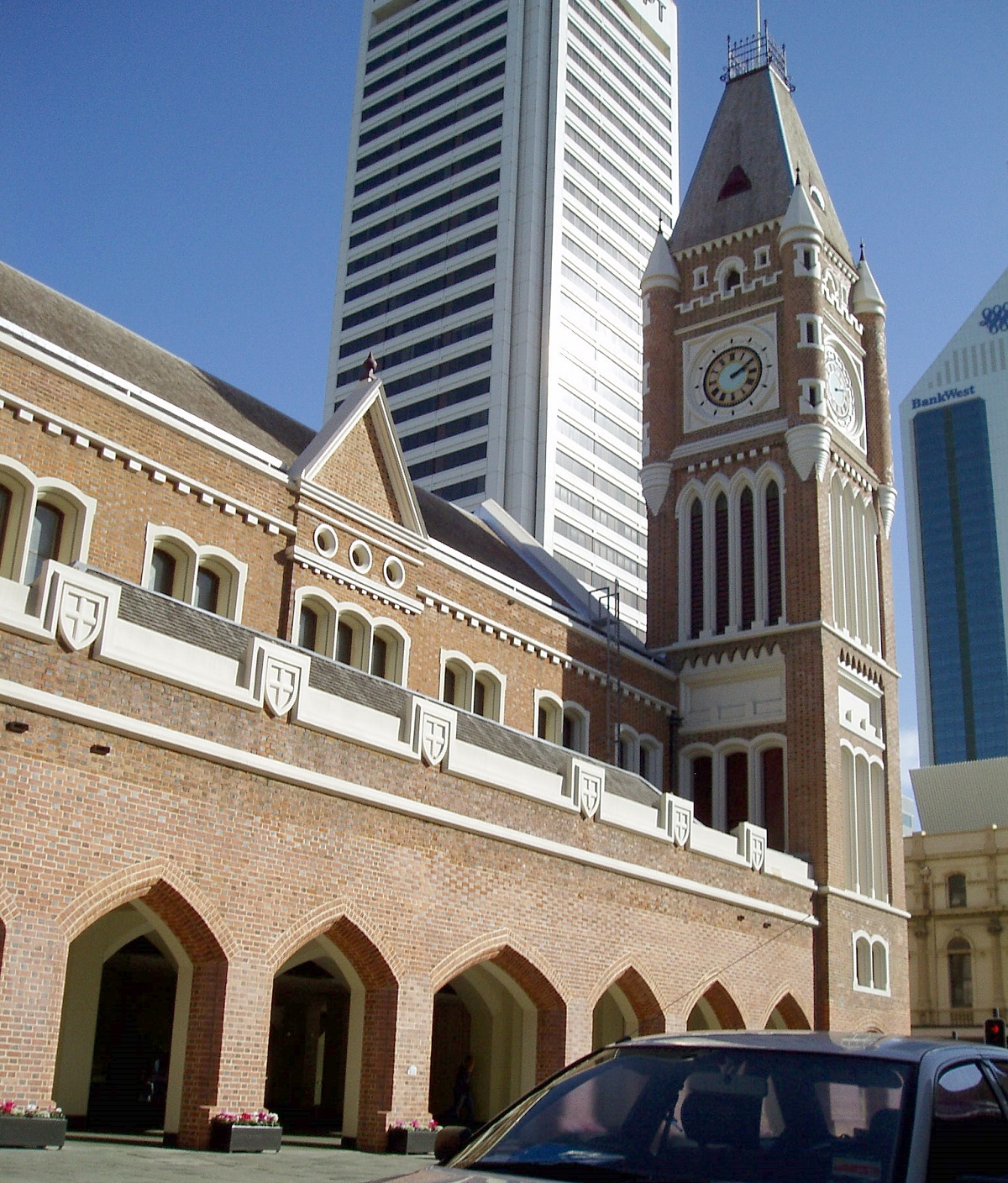
The Town Hall is Perth’s cityhall and is one of the oldest and most important public buildings from its time. The town hall was built 1867-1870 with the help of labor from convicts in the then colony. It was the only town hall in Australia built by convicts.
At its opening, the Town Hall was the tallest building in the city. It was the architects Richard Roach Jewell and James Manning who designed the building in the Victorian neo-Gothic period, and the foundation stone was laid by the Governor of Western Australia, John Stephen Hampton.
Parliament House in Perth is the seat of the parliament of the Australian state of Western Australia. Parliament consists of the upper house, the Legislative Council, and the lower house, the Legislative Assembly, and both chambers have meeting rooms in the parliament building.
The original council meetings of the Swan River Colony from 1832 were held in smaller government offices on St Georges Terrace, and later the meetings of the second chamber were held in another building. In 1897, plans were passed to bring Parliament together in a new and unified building.
The construction of Parliament House started in 1902 with a neoclassical facade. It was a style that was often used in public buildings during this period. Parliament opened in 1904 and later expanded. On the facade you can see statues of a lion and a unicorn that came from the Parliament in London. The lion symbolizes England, while the unicorn is a symbol of Scotland.
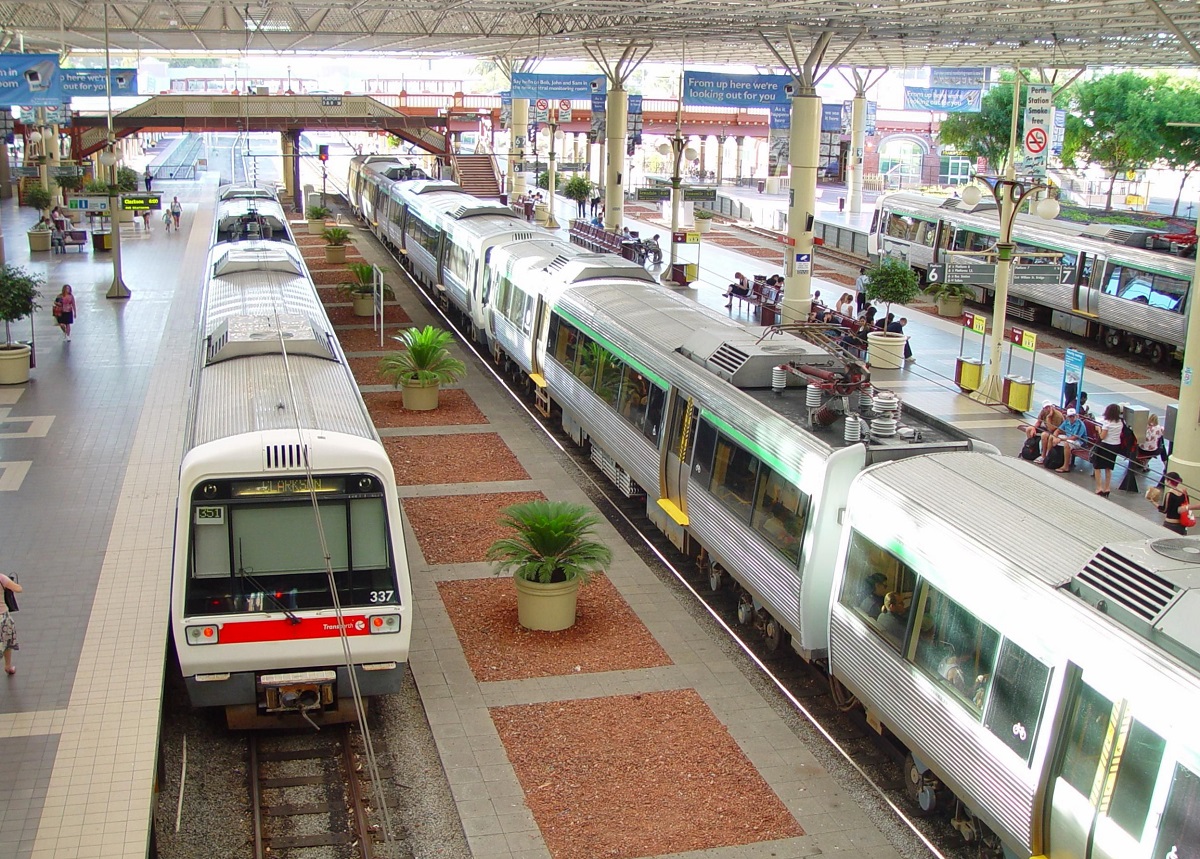
Perth Railway Station is Perth’s main railway station and thus one of the city’s traffic hubs. The Victorian railway station building is also known as the terminus of one of the world’s great railway constructions, The Indian Pacific, which crosses the country between the Indian Ocean and the Pacific Ocean.
The first station in Perth was opened in 1880 as part of the Eastern Railway between Fremantle and Guildford. The station became too small before the end of the decade, and it was decided to build a new station, which is the current one, which opened in 1894. The first station was demolished, and since opening, Perth Railway Station has been extended several times.
The Swan Bells Tower is one of Perth’s most distinctive modern buildings. The tower was erected to celebrate the turn of the millennium in 2000. The building was designed by local architect, Hames Sharley, and is an 82.5 meter tall bell tower with 18 bells, which was constructed with significant use of copper and glass.
The tower stands beautifully on Elizabeth Quay and the Swan River, after which it is named. 12 of the tower’s 18 bells have a special history, coming from the church of St Martin-in-the-Fields in Trafalgar Square in London, England. The history of the bells goes back to the 14th century, and they rang, among other things, when James Cook sailed from London on the trip that brought him to Australia.
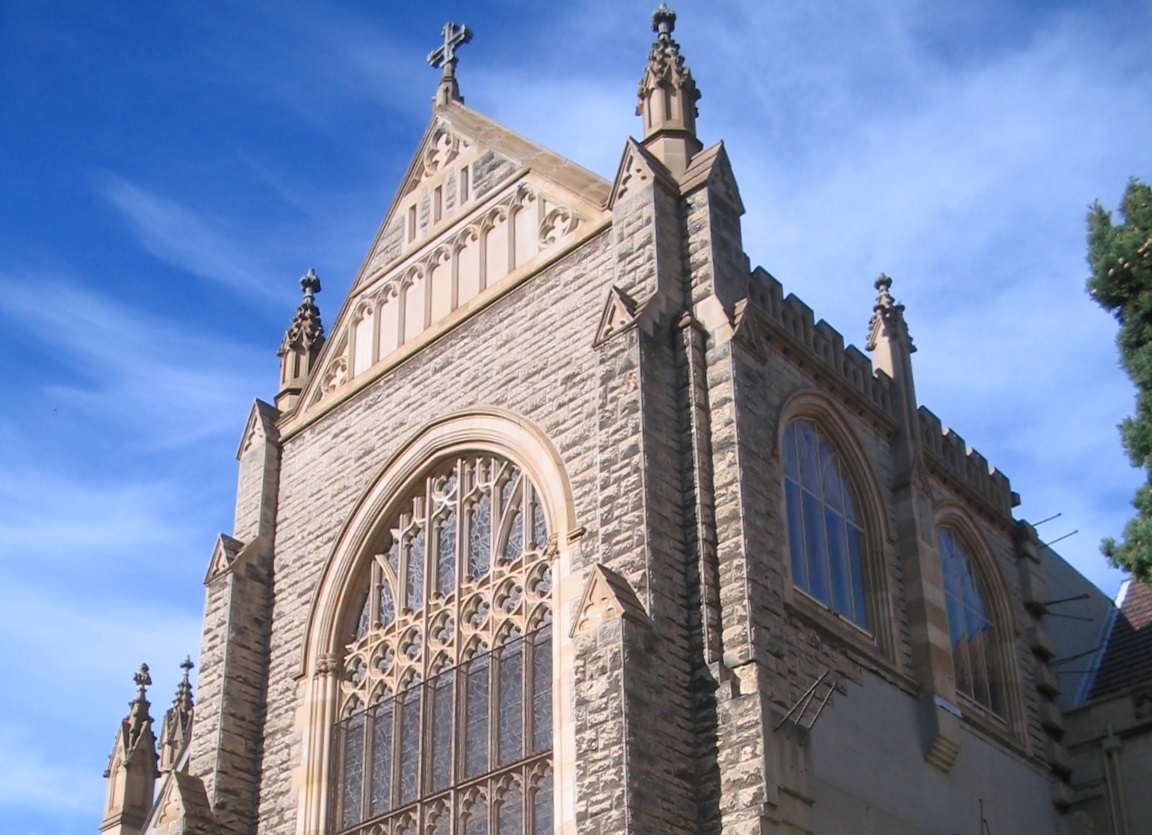
St. Mary’s Cathedral is Perth’s Gothic Catholic cathedral. The church was built on one of the highest places in the central city and stands beautifully in the surroundings. There should originally have been an Anglican church here, but the site was then deemed to be too far away from the city centre.
The cathedral was founded in 1863 and built in several stages. The first phase was completed in 1865, and then it took until 1973 before the next part of the construction was completed. The last phase and thus the end of construction was inaugurated in 2009.
Today, you can see the cathedral with an exciting architectural mix, where you can clearly see the most recently built parts, such as the one tower, which is a simplified version of the first one. Inside, there are also built and furnished elements rooms and modern extensions with light and air.
The Supreme Court of Western Australia is the highest court in the state of Western Australia. Its history dates back to the establishment of the then colony’s Supreme Court in 1861. In the following decades, the court’s resort areas grew, and a new and larger building became necessary over time.
Plans for a new courthouse were published in 1901 after a parliamentary committee pointed to the current location on St Georges Terrace. Construction began in 1902 and opened in 1903. It was the architect John Harry Grainger who designed the building in the neoclassicism often used at the time.
Chinatown in Perth is a small area along and between Roe Street and James Street in Perth. There are a number of Chinese shops and restaurants in the area, and Chinatown is also the center of Chinese cultural events and celebrations.
The Chinese population and other Asians have settled in various places in Perth over the years. Thus, you also find many Asian shops in William Street, but the concentration is in Chinatown, where along Roe Street you can see a Chinese portal.
His Majesty’s Theater is a theater in Perth which was built in the Edwardian Baroque style in the years 1902-1904. Perth experienced great growth in the early 1900s, where a number of buildings and impressive constructions such as His Majesty’s Theater were erected.
The theater was opened as the largest in Australia, seating an audience of 2,500. Over time, there have been countless major productions on the stage, which is now home to the West Australian Ballet and the West Australian Opera, both of which have regular performances at the beautiful theatre.
The Art Gallery of Western Australia is an art museum located as part of the Perth Cultural Centre. The museum was founded in 1895 and was originally located in the Jubilee Building, which is now part of the Western Australian Museum.
Today, the collection has grown to many thousands of works, and the museum moved into the current main building in 1979. It was designed with brutalist inspiration by Charles Sierakowski. Among other things, you can see a fine collection of art from the Northern Territory and Western Australia.
Elizabeth Quay is a modern harbor area in central Perth on the Swan River. Project development was started in 2012, and the naming took place at the same time. The inauguration of the attractive area took place in 2016, and today there are several things to see here.
You can take a lovely stroll around the harbor area along winding paths with beautiful decorations. Part of the tour goes along the s-shaped Elizabeth Quay Bridge, from which you have a panoramic view of the entire area, which is a popular spot in the city centre.
The Old Court House in Perth is a courthouse that was built in 1836. It was the first courthouse to be built in the city and the Old Court House is today the oldest surviving public building in Perth. In the early years, the building also served as a church, until St George’s Church opened in 1842.
It was the colonial engineer Henry Willey Reveley who designed the house, as he also did with other administration buildings in the Swan River Colony of the time. The architecture is a good example of a Georgian building with Greek-classical inspiration.
Yagan Square is a modern urban space located between the Horseshoe Bridge and Perth Busport immediately north of Perth city centre. The square was laid out from 2016 and opened in 2018, where it was named after the Aboriginal warrior Yagan of the Noongar Aboriginal people.
One can see 14 pillars in Yagan Square. They represent the 14 Noongar language groups of the area’s Aboriginal people. The 9 meter tall statue Wirin also stands in the square. It was designed by Noongar artist Tjyllyungoo and represents the sacred force that connects life on Mother Earth.
At Yagan Square, you are also surrounded by exciting modern architecture, where the interplay of surfaces creates a beautiful whole. A digital tower has also been installed on the square, where events can also be held in a constructed amphitheater.
The Regal Theater is a theater located in the suburb of Subiaco to the west of central Perth. It is a beautiful example of Art Deco architecture in the city and was built by the wealthy Coade-Hewett family.
The theater was built as a cinema from 1937 and opened the following year. It was named after King George VI, who had taken over the throne at the time. In 1977, the theater was converted to live performances after its time with film screenings.
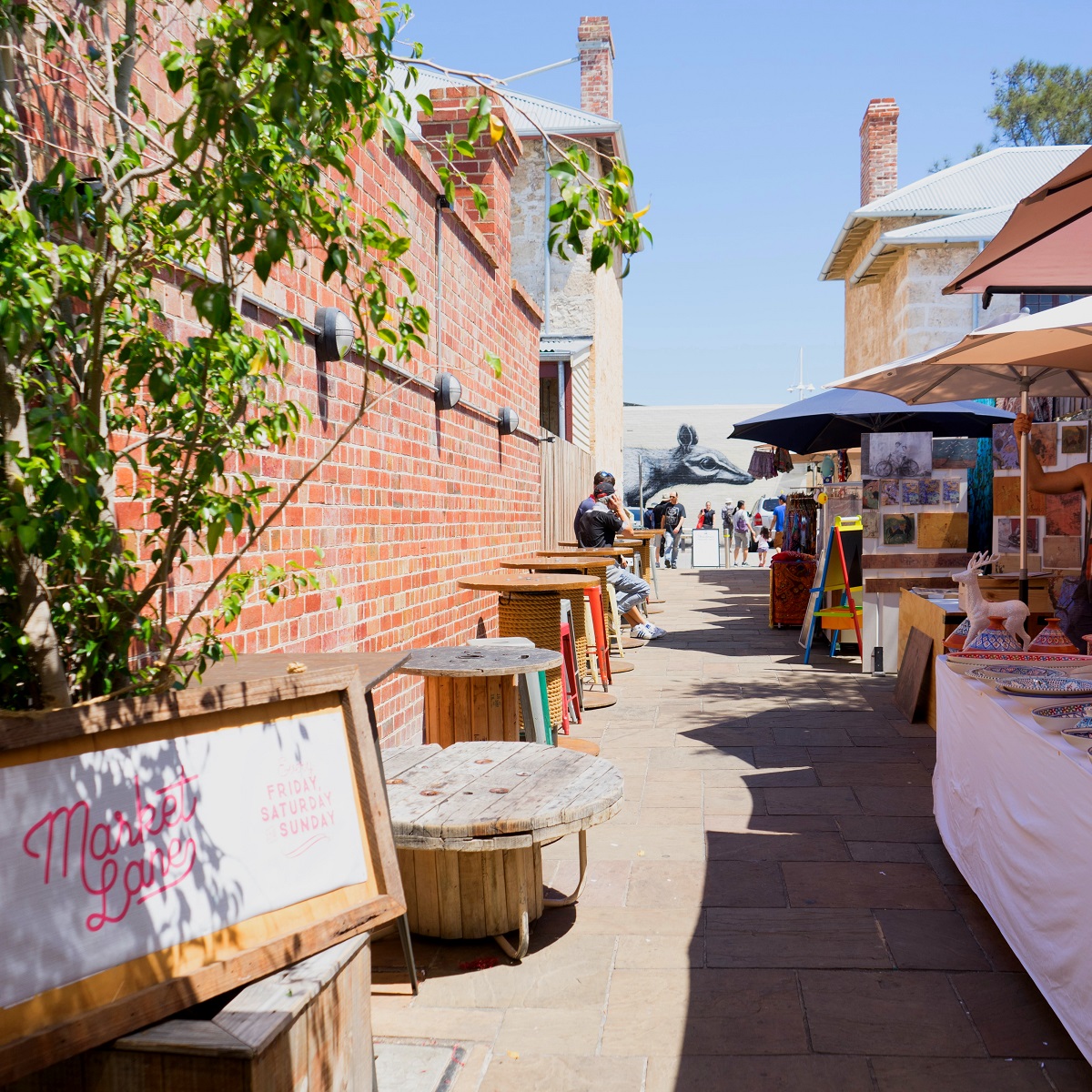
Fremantle is one of Western Australia’s lovely towns along the Indian Ocean coast. The location provides a wealth of opportunities for recreation and activities by and in the water; eg boat trips to Rottnest Island, swimming and surfing.
Fremantle’s history is interesting, and you can see some buildings from the 19th century, where the city was founded at about the same time as the metropolitan city of Perth, which Fremantle today is the suburb and port city of. Since then the development has gone strong, but in the streets there are beautiful sights like houses from, for example, the Victorian era.
The Swan Valley is an area located along the course of the Swan River northeast of Perth. The area is known for its fertile soil, uncommon in the Perth region, and the Swan Valley has also become a major excursion destination.
Popular locations include several wineries ranging in volume from small family-owned businesses to some of Western Australia’s largest producers. In addition to the wines, you can find microbreweries and the purchase of agricultural products such as grapes, melons, strawberries and more.
The history of the wine region started already in the 1800s, when settlers sailed up the Swan River to find new fertile lands they could cultivate. The climate with Western Australia’s many hours of sunshine and the soils produce lovely wines that you can taste on a trip here.
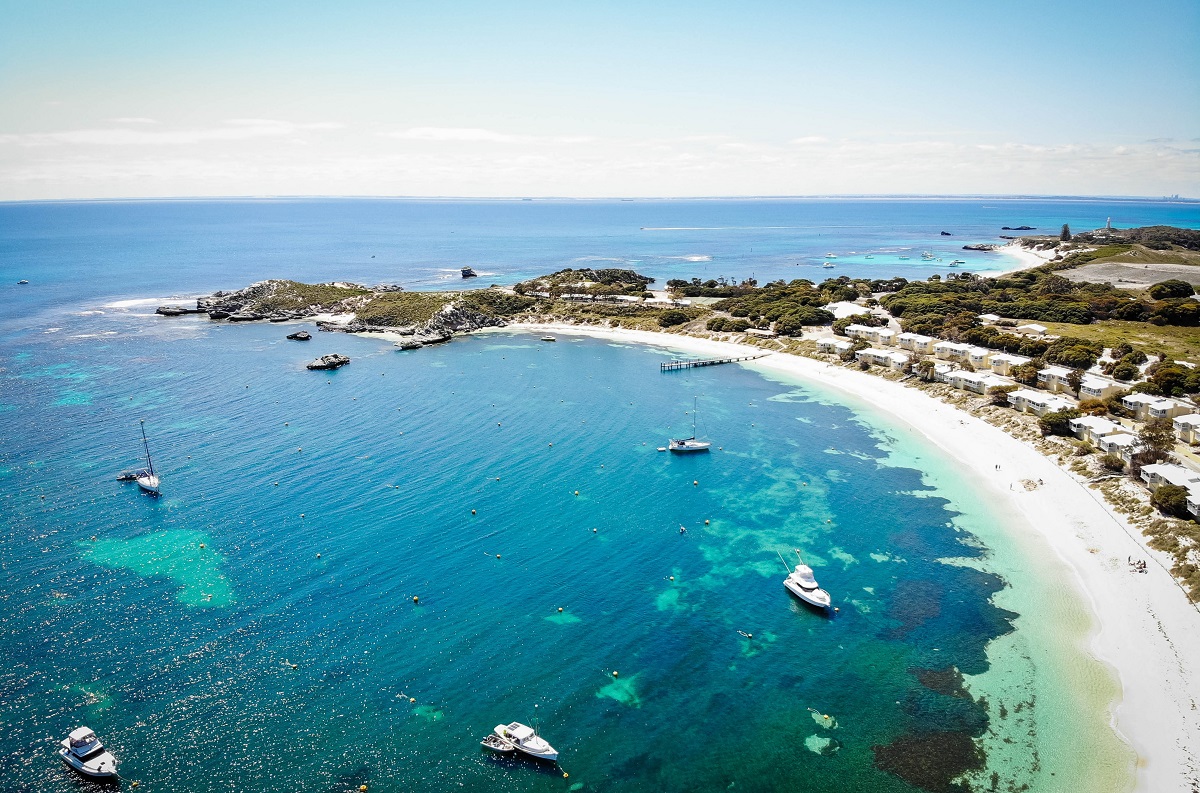
Rottnest Island is an island known for having some of Australia’s best beaches and diving areas. The island lies in the Indian Ocean west of Perth and Fremantle, and it is easy to sail to Rottnest Island from, for example, central Perth.
Rottnest Island was separated from the Australian mainland approximately 7,000 years ago when sea levels rose. Much older evidence of human activity has been found on the island, which today is known for its lovely nature. In the island’s many bays, for example, you can find warm and shallow water, so that all swimmers can participate, and there is a rich wildlife here.
However, the island’s recent history is also interesting. When the British established the Swan River Colony in 1829, they also established themselves on Rottnest Island to cultivate the island. From 1838 to 1931, the remote island was also used as a prison and labor camp for Aboriginal people.
Rockingham is a town by the sea, situated as a southern suburb of the big city of Perth. The city is a lovely place, known for its beaches and many maritime opportunities. You can, for example, go on boat or fishing trips from the harbor in Rockingham, and surfing is also popular here.
The name Rockingham comes from one of the three ships that Thomas Peel chartered to sail settlers to Western Australia. Rockingham came to the area on 14 May 1830 and it then drifted out to sea and sank after several attempts to save the ship. Some of the arrivals reportedly settled on the shore at the wreck site and it became Rockingham.
Today you can enjoy the atmosphere and the walks along the Indian Ocean. You can also go for a walk to Rockingham Naval Memorial Park, a military monument along the water north of town. In the park there are several commemorative plaques and you can see a gun turret from HMAS Derwent and a submarine fin from HMAS Orion.
New Norcia is Australia’s only monastic town. It was founded by a group of Benedictine monks in 1847, and with its many historic buildings, it gives an impression of former Spanish colonies. It was also the Spanish monks Giuseppe Serra and Rosendo Salvado who started the settlement of the mission town.
New Norcia was named after Italian Norcia, which was the birthplace of Saint Benedict. Monks had been in contact with Aborigines for two years before the foundation, and they decided that it was better to establish a mission than to follow the Aborigines’ journey, and thus New Norcia became a reality.
Today, New Norcia continues to consist of the many monastic buildings that stand as a special attraction in the Australian nature. You can start by visiting the New Norcia Visitor Centre, located in the old monastery, and from here you can take a walk past the girls’ school St Gertrude’s College and the boys’ school St Ildephonsus’ College.
In the same area you can see the old New Norcia Hotel, where parents of children at the convent schools could stay. If you go east of New Norcia Road, you will come to the mission’s abbey church and the large monastery building. There is informative signage in the area, where there are also workshops and other service buildings for the monastery.
207 Murray Street
carillloncity.com.au
1382 Albany Highway
westfield.com/carousel
Murray Street
forrestchase.com.au
840 Wellington Street
harbourtownperth.com.au
Ellen Stirling Boulevard
whitfield.com/innaloo
Hay Street Mall
londoncourt.com.au
Marmion Avenue/Whitfords Avenue
westfield.com/whitforcity
Barrack Street, Hay Street, King Street, Murray Street, St. Georges Terrace
Perth Zoo
Labouchere Road
perthzoo.wa.gov.au
Scitech Discovery Center
Sutherland Street
scitech.org.au
Aqwa
Sorrento Quay, Hillarys Boat Harbor
aqwa.com.au/main.asp
Adventure World
179 Progress Drive, Bibra Lake
adventureworld.net.au
Fremantle Tram Tour
King’s Square, Fremantle
fremantletrams.com
Western Australian Maritime Museum
Victoria Quay, Fremantle
museum.wa.gov.au/maritime
In Australia, Aboriginal people, the country’s indigenous population, have lived for thousands of years. It was not until 1616 when the first Europeans came to the west of the great Australian land. It was the Dutch Dirk Hartog who went ashore at Shark Bay near Carnarvon.
In 1828, British ships sailed up the Swan River, and the following year, Britain claimed territory after Captain Fremantle’s departure. In 1829 Captain James Stirling sailed farther into the Swan River and, along with a group of settlers, founded Perth on the site where the town hall now stands. The town was named after the British minister, Sir George Murray’s birth name Perthshire.
The colony at Swan River experienced difficulties at the beginning of its time. The location far away from pretty much everything else provided manpower shortages, financial challenges and communication difficulties. The British government came to the rescue by sending thousands of prisoners to the cities of the area in the period 1850-1868, which could then help to greatly increase the rate of expansion of the area.
Perth was expanded and many of the historic buildings one can see today were built using the prisoners’ labor. This goes for, among other, the Town Hall and the Government House, which was the seat of the Free State of Western Australia, thus making Perth its capital.
However, despite the new cheap labor, Perth did not develop as rapidly as the cities on the east coast. Large discoveries of gold in the 1890s, however, caused the development to explode. Perth’s population has quadrupled in just a decade.
In the year 1901, the state of Western Australia became a part of the newly formed Commenwealth of Australia by a vote. The isolated Western Australia with the capital Perth at the forefront required, among other things, a railroad connection across the vast and desolate landscape to form the new nation. The construction of the railroad line started after preliminary investigations in 1912, and the line became an important source of trade and communication across the country. Large discoveries by gold and nickel could now be more easily exported, which helped to increase Perth’s prosperity.
Perth grew throughout the 20th century and the rich natural deposits of Western Australia constantly brought new wealth to the city. Many historic buildings were demolished to be replaced by modern skyscrapers.
Today, around 1.5 million people live in Perth, which is the majority of Western Australia’s population. The city has renovated its historic buildings and built very new ones, providing a beautiful, modern skyline. Tourism to the area has also evolved sharply, not least due to the natural riches that start in Perth itself with its beautiful location.

Perth, Australia
Overview of Perth
Perth is the largest city in Western Australia and also the capital of the state of Western Australia. The city is named after Perth in Scotland, and with more than two million inhabitants in the metropolitan area, it has grown rapidly from its founding in 1829 to the present.
Perth offers a wide variety of sights and activities. The city’s skyscrapers in the central business district tower up and create a beautiful skyline that can be seen from many of the city’s recreational areas. In Perth, there are large parks and water that serve as oases for both citizens and tourists.
About the Whitehorse travel guide
Contents: Tours in the city + tours in the surrounding area
Published: Released soon
Author: Stig Albeck
Publisher: Vamados.com
Language: English
About the travel guide
The Whitehorse travel guide gives you an overview of the sights and activities of the Canadian city. Read about top sights and other sights, and get a tour guide with tour suggestions and detailed descriptions of all the city’s most important churches, monuments, mansions, museums, etc.
Whitehorse is waiting for you, and at vamados.com you can also find cheap flights and great deals on hotels for your trip. You just select your travel dates and then you get flight and accommodation suggestions in and around the city.
Read more about Whitehorse and Canada
Canada Travel Guide: https://vamados.com/canada
City tourism: https://visitwhite-horse.ca
Main Page: https://www.vamados.com/
Buy the travel guide
Click the “Add to Cart” button to purchase the travel guide. After that you will come to the payment, where you enter the purchase and payment information. Upon payment of the travel guide, you will immediately receive a receipt with a link to download your purchase. You can download the travel guide immediately or use the download link in the email later.
Use the travel guide
When you buy the travel guide to Whitehorse you get the book online so you can have it on your phone, tablet or computer – and of course you can choose to print it. Use the maps and tour suggestions and you will have a good and content-rich journey.


The Town Hall is Perth’s cityhall and is one of the oldest and most important public buildings from its time. The town hall was built 1867-1870 with the help of labor from convicts in the then colony. It was the only town hall in Australia built by convicts.
At its opening, the Town Hall was the tallest building in the city. It was the architects Richard Roach Jewell and James Manning who designed the building in the Victorian neo-Gothic period, and the foundation stone was laid by the Governor of Western Australia, John Stephen Hampton.
Parliament House in Perth is the seat of the parliament of the Australian state of Western Australia. Parliament consists of the upper house, the Legislative Council, and the lower house, the Legislative Assembly, and both chambers have meeting rooms in the parliament building.
The original council meetings of the Swan River Colony from 1832 were held in smaller government offices on St Georges Terrace, and later the meetings of the second chamber were held in another building. In 1897, plans were passed to bring Parliament together in a new and unified building.
The construction of Parliament House started in 1902 with a neoclassical facade. It was a style that was often used in public buildings during this period. Parliament opened in 1904 and later expanded. On the facade you can see statues of a lion and a unicorn that came from the Parliament in London. The lion symbolizes England, while the unicorn is a symbol of Scotland.

Perth Railway Station is Perth’s main railway station and thus one of the city’s traffic hubs. The Victorian railway station building is also known as the terminus of one of the world’s great railway constructions, The Indian Pacific, which crosses the country between the Indian Ocean and the Pacific Ocean.
The first station in Perth was opened in 1880 as part of the Eastern Railway between Fremantle and Guildford. The station became too small before the end of the decade, and it was decided to build a new station, which is the current one, which opened in 1894. The first station was demolished, and since opening, Perth Railway Station has been extended several times.
The Swan Bells Tower is one of Perth’s most distinctive modern buildings. The tower was erected to celebrate the turn of the millennium in 2000. The building was designed by local architect, Hames Sharley, and is an 82.5 meter tall bell tower with 18 bells, which was constructed with significant use of copper and glass.
The tower stands beautifully on Elizabeth Quay and the Swan River, after which it is named. 12 of the tower’s 18 bells have a special history, coming from the church of St Martin-in-the-Fields in Trafalgar Square in London, England. The history of the bells goes back to the 14th century, and they rang, among other things, when James Cook sailed from London on the trip that brought him to Australia.

St. Mary’s Cathedral is Perth’s Gothic Catholic cathedral. The church was built on one of the highest places in the central city and stands beautifully in the surroundings. There should originally have been an Anglican church here, but the site was then deemed to be too far away from the city centre.
The cathedral was founded in 1863 and built in several stages. The first phase was completed in 1865, and then it took until 1973 before the next part of the construction was completed. The last phase and thus the end of construction was inaugurated in 2009.
Today, you can see the cathedral with an exciting architectural mix, where you can clearly see the most recently built parts, such as the one tower, which is a simplified version of the first one. Inside, there are also built and furnished elements rooms and modern extensions with light and air.
The Supreme Court of Western Australia is the highest court in the state of Western Australia. Its history dates back to the establishment of the then colony’s Supreme Court in 1861. In the following decades, the court’s resort areas grew, and a new and larger building became necessary over time.
Plans for a new courthouse were published in 1901 after a parliamentary committee pointed to the current location on St Georges Terrace. Construction began in 1902 and opened in 1903. It was the architect John Harry Grainger who designed the building in the neoclassicism often used at the time.
Chinatown in Perth is a small area along and between Roe Street and James Street in Perth. There are a number of Chinese shops and restaurants in the area, and Chinatown is also the center of Chinese cultural events and celebrations.
The Chinese population and other Asians have settled in various places in Perth over the years. Thus, you also find many Asian shops in William Street, but the concentration is in Chinatown, where along Roe Street you can see a Chinese portal.
His Majesty’s Theater is a theater in Perth which was built in the Edwardian Baroque style in the years 1902-1904. Perth experienced great growth in the early 1900s, where a number of buildings and impressive constructions such as His Majesty’s Theater were erected.
The theater was opened as the largest in Australia, seating an audience of 2,500. Over time, there have been countless major productions on the stage, which is now home to the West Australian Ballet and the West Australian Opera, both of which have regular performances at the beautiful theatre.
The Art Gallery of Western Australia is an art museum located as part of the Perth Cultural Centre. The museum was founded in 1895 and was originally located in the Jubilee Building, which is now part of the Western Australian Museum.
Today, the collection has grown to many thousands of works, and the museum moved into the current main building in 1979. It was designed with brutalist inspiration by Charles Sierakowski. Among other things, you can see a fine collection of art from the Northern Territory and Western Australia.
Elizabeth Quay is a modern harbor area in central Perth on the Swan River. Project development was started in 2012, and the naming took place at the same time. The inauguration of the attractive area took place in 2016, and today there are several things to see here.
You can take a lovely stroll around the harbor area along winding paths with beautiful decorations. Part of the tour goes along the s-shaped Elizabeth Quay Bridge, from which you have a panoramic view of the entire area, which is a popular spot in the city centre.
The Old Court House in Perth is a courthouse that was built in 1836. It was the first courthouse to be built in the city and the Old Court House is today the oldest surviving public building in Perth. In the early years, the building also served as a church, until St George’s Church opened in 1842.
It was the colonial engineer Henry Willey Reveley who designed the house, as he also did with other administration buildings in the Swan River Colony of the time. The architecture is a good example of a Georgian building with Greek-classical inspiration.
Yagan Square is a modern urban space located between the Horseshoe Bridge and Perth Busport immediately north of Perth city centre. The square was laid out from 2016 and opened in 2018, where it was named after the Aboriginal warrior Yagan of the Noongar Aboriginal people.
One can see 14 pillars in Yagan Square. They represent the 14 Noongar language groups of the area’s Aboriginal people. The 9 meter tall statue Wirin also stands in the square. It was designed by Noongar artist Tjyllyungoo and represents the sacred force that connects life on Mother Earth.
At Yagan Square, you are also surrounded by exciting modern architecture, where the interplay of surfaces creates a beautiful whole. A digital tower has also been installed on the square, where events can also be held in a constructed amphitheater.
The Regal Theater is a theater located in the suburb of Subiaco to the west of central Perth. It is a beautiful example of Art Deco architecture in the city and was built by the wealthy Coade-Hewett family.
The theater was built as a cinema from 1937 and opened the following year. It was named after King George VI, who had taken over the throne at the time. In 1977, the theater was converted to live performances after its time with film screenings.
Similar to Perth Travel Guide
